|
Get
the Guide
To really understand the problem of radon gas, read and
print this excellent booklet by the Environmental Protection
Agency:
A Citizen's Guide to Radon.
|
The Problem
Lung
Cancer
Radon gas causes lung cancer at the rate of 21,000 deaths a
year (that's 60 a day!), second only to cigarette smoke. According
to the Center for Disease Control, "more people die from
lung cancer than any other type of cancer. This is true for
both men and women.
"The biggest problem with lung cancer is that there are
often no symptoms that it's there until its gone very far,"
said the Cleveland Clinic's Dr. Peter Mazzone. About
6 out of 10 people with lung cancer die within a year of being
diagnosed with the disease.
Lack
of Research Funding
The Lungevity Foundation reports that: "Lung cancer
accounts for more deaths each year than breast cancer, prostate
cancer, and colon cancer, combined. But Lung cancer
gets few of the research dollars because of the perception it
is self-inflicted by smoking. In 2003, approximately $1,740
was spent on research per lung cancer death, compared with:
$13,649 per breast cancer death, $10,560 per prostate cancer
death and $4,581 per colorectal cancer death."
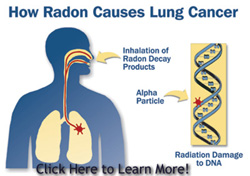 20
Year Wait 20
Year Wait
A problem with getting people motivated to fix high levels of
radon, is that the damage may take a long time to manifest as
lung cancer. Depending on the level of radon in your home, the
time you spend in your home, and if you have ever smoked, cancer
may take years to develop. As busy as we are, we tend to put
off fixing what is not perceived as an immediate problem.
Radiation
is cumulative
Science is still studying how cancer develops, but the medical
experts agree that exposure to any radiation has a cumulative
effect in causing cancer where each new infraction adds to the
damage until some critical mass is reached. Factors such as
the level of radon, the amount of time spent in the house, the
addition of smoking, free radicals in junk foods, and exposure
to other radiation such as excessive
medical x-rays, along with genetic predisposition, all contribute
to reaching the critical mass. The good news is that for those
who have been exposed to high levels of radon, they can lower
their risks of getting cancer by avoiding exposure to other
high risk factors, and, of course, eliminating exposure to radon
in their home.
The
2009
Tahoe Radon Survey by the California Geological Survey simplifies
the process of getting lung cancer from radon:
"Although
radon levels are used as a guide for acceptable exposure and
for remedial action, it is inhalation of two radon radioactive
decay products that primarily lead to lung cancer: polonium-218
and polonium-214. These daughter elements have very short half-lives,
and when they enter the lungs they attach to lung tissue or
trapped dust particles and quickly undergo radioactive decay.
In contrast, longer-lived radon-222 is mostly exhaled before
it undergoes radioactive decay. Alpha particles emitted during
decay of radon-222, polonium-218 and polonium-214 are thought
to cause cancer by damaging the DNA (deoxyribonucleic acid)
in lung tissue cells, resulting in abnormal or tumorous cell
growth (Brookins, 1990)."
 EPA
Public Service Announcements EPA
Public Service Announcements
The
EPA has produced some PSA's that are available FREE to TV stations.
Call your local TV station and request that they air these informational
messages.
Click
here to view the PSA's.
CANSAR
- Cancer Survivors Against Radon
To
put a face on radon induced cancer, these brave folks share
their stories so that others can avoid their fate, For a more
personal look at the effects of radon, visit their web site
at http://www.cansar.org/
.
"My
name is Elizabeth Hoffmann and I’m a survivor of radon
induced lung cancer. Although, I have never smoked, my 15-year
exposure to dangerous levels of radon in my home resulted in
doctors having to remove the cancerous lower lobe of my left
lung prior to my 38th birthday...." (read
more).
It
gets trapped in your house
It is a natural occurring radioactive gas found in all soils,
but is concentrated in decomposed granite soils like those at
Tahoe. Out in the open it dissipates and mixes with our atmosphere
to safer levels, but when it seeps into a house it is trapped
and concentrates to unhealthy levels.
You
don't know it's there
Radon gas is colorless, odorless and tasteless, so you have
no idea there is a problem. Smoking combined with radon is an
especially serious lung cancer risk.
Testing
methods vary
There are many methods of testing for radon which can confuse
a homeowner and prevent them from taking action. Any testing
is better than no testing. All tests should be done in the living
area, on the ground floor, with windows closed and away from
heaters and drafts. Follow the directions for each test application.
Each
method has its tradeoffs. Some are inexpensive but can only
be used once. Monitors that can be used continuously are moderately
expensive. Some you can do yourself. Some are best performed
by professional testers. Professional testers can give printed
reports for real estate transactions. Some machines indicate
movement to thwart attempts to tamper with the test. Professional
tests are usually more costly but you can depend that they are
performed correctly. Charcoal canister tests can take weeks
to get results back from the lab, requiring multiple tests to
correlate corrective remedial action with radon reduction. Radon
readings vary from day to day and from season to season so results
from a one-time test may not give a complete long term picture.
It is also easy to loose your momentum in fixing the problem
when the results arrive so long after the actual test. Continuous
monitors give results in a few days. (See the Solutions section.)
Poor
availability of testing and mitigation equipment
Local hardware stores and lumber yards do not carry testing
or mitigation equipment, forcing homeowners to devise their
own solutions or to order from unfamiliar catalog companies.
(The Solution section lists several radon product companies).
Few
local professionals
Finding a "certified" radon tester and mitigator close
to Tahoe can be a challenge. As of 2005, I located two testers
in Sacramento, one in Carson City and one in Reno. (See NEHA's
list of Residential Measurement Provider). The official
California Certified Mitigator page lists only 4 in the whole
state, all in Southern California. And I found only one
mitigator in Reno. (See Solutions section). Finding qualified
professionals is a chore and paying for their travel time is
costly. Professional fees for testing and mitigating can run
into thousands of dollars.
Little
help for the do-it-yourselfer
Many homeowners have lacked the knowledge and confidence to
tackle the job of testing and mitigating radon themselves. In
the Do-it-yourself section you will find the steps I used and
the problems I encountered. Non-certified consultants are restricted
by California State law from giving advise regarding radon testing
or mitigation, so most knowledge has to gained by individual
research. The Internet is a big help here.
Radon
is everywhere
But nearby locations can have dramatically different radon readings,
even in the same neighborhoods. Thus you can't generalize or
assume your house is safe without testing. The EPA radon maps
below attempt to show relative radon concentrations, but are
not of much use to the homeowner who is deciding whether to
test since high radon levels can be found in low density areas,
and low radon levels in the high density areas.
EPA
maps of California and Nevada radon concentrations

Nevada Bureau of Mines and Geology conducted their own study of radon in Nevada in 1989, 1991-1992, and 1992-1993. Here is a link to the summary report: http://134.197.46.69/dox/nl/nl24.htm.
Here is a link to a copy of that summary if the above link fails.
This may be the same study quoted in the Nevada map above by the Nevada State Health Division since the dates seem to correlate, but the numbers on the map and on the report are slightly different. This report still shows elevated levels for Tahoe Communities, but does not specifically mention Zephyr Cove with 69% of homes over the EPA action level. I present both report and map for your consideration.
The
California map lacks sufficient detail to show us the Lake Tahoe
areas of radon concentration. A study of radon in the Sierras
was done by the State of California in 1993 and another was
just completed in 2004, but I have not been able to find out
the results of either test yet. But remember, radon concentrations
vary from site to site so the only way to know if you are getting
high concentrations is to test your site.
Interestingly,
the first Nevada map shows dangerous radon levels in Carson
City and Washoe and Douglas Counties in the Lake Tahoe region,
whereas the California map averages in Tahoe's high readings
with the west slope of El Dorado County to show moderate levels.
Again, there is not sufficient detail to make a determination.
Only testing proves the point for a specific property.
Zephyr Cove is the worst radon city in Nevada
The
second Nevada map shows the Lake Tahoe community of Zephyr Cove
with 69%, a very high percentage of homes tested with readings
above the EPA recommended action level of 4 pCi/L. This was
a limited test in 1989 - 1991, but it is the best info we have
to date and it is nearly 7 times above the estimated 10% average
for all homes in Nevada.
Existing
EPA and State radon maps are by state and county, leaving the
local areas without sufficient detail to note high levels of
radon. So again I will say that taking the
test is the only way for individual homeowners to know what
their radon levels are. (Are you getting the point?)
George
Faggella, of the California Department of Health Services, Radon
Department, has maps for only 2 counties, Ventura and Santa
Barbara, with Los Angeles and San Luis Obisbo in the works.
To view the PDF files, click on the maps.
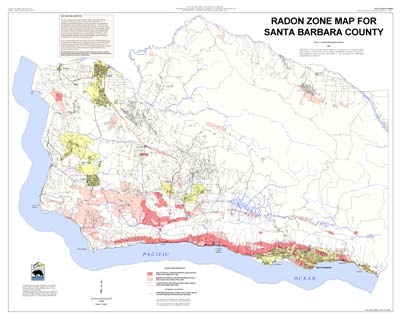
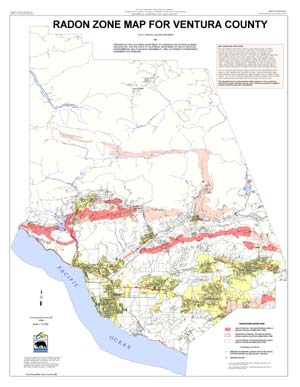
Los Angeles County Radon Map of 2005
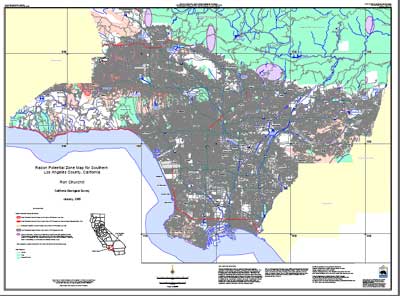
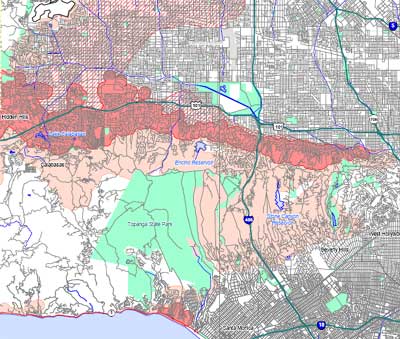
What is interesting to me in this map, which is due to be re-drawn in 2009, is that there are some hot spots in the Santa Monica Mountains, in Chatsworth and in Pacific Palisades. If you live in these areas, take a radon test! Click on the image to download the actual map to check out your area. The California Geological Society is in the process of doing Geological Radon Maps for various areas of California. Look for the Tahoe Area Radon Map to be completed by 2009. California Geological Survey of Radon in California, 1991
A Sad Case of Knowledge and Inaction
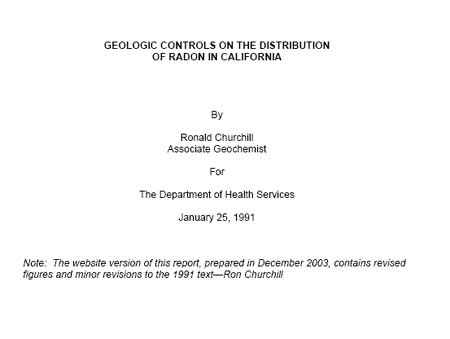
The map below and the full radon report show how much we knew about radon in the Sierra Nevada back in 1991, yet translating science to political action is a task we need to get better at. The geological report explains in detail how radon is distributed in California, yet nothing was done about it. This is an example of communication disconnect, or the right hand not knowing what the left hand is doing in government. When will County Government act on this report? My fear is they do not know it exists. Read the full report.
California Geological Map
Shows granite areas in red. 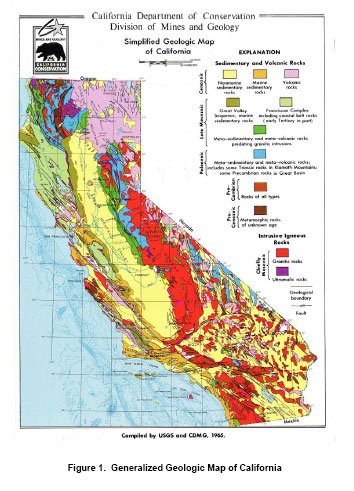
U.S.
Geological Survey Terrestrial Gamma Radioactivity Maps
For more information about these aerial gamma-ray photos and
the survey which is used for unanium mining, go to the USGS
web site at http://energy.cr.usgs.gov/radon/DDS-9.html
It
is interesting that all of the maps below show very high concentrations
of radioactivity around Tahoe, in the Sierra Nevadas, and in
Western Nevada.
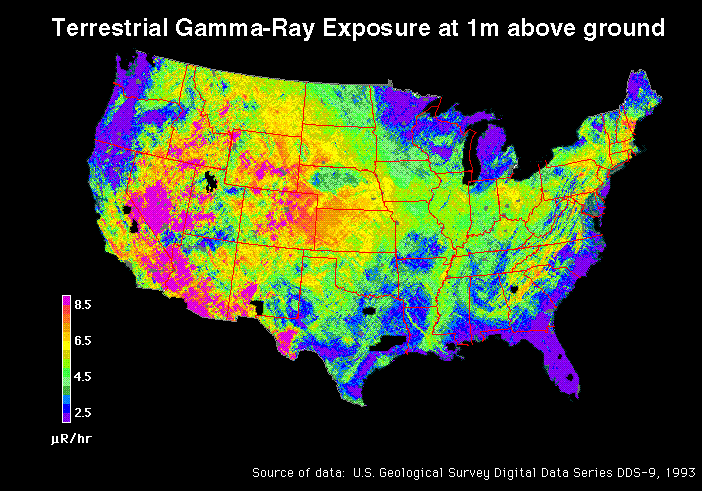
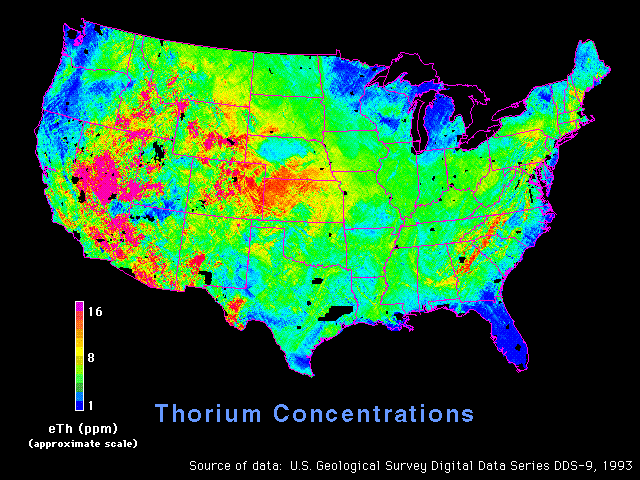

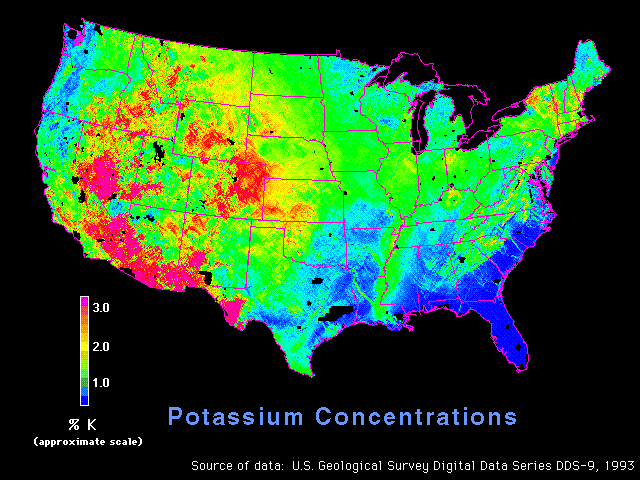
Local
"Hot Spots"
I have spoken to several radon testers who have tested homes
in and around Tahoe and some areas are known to have higher
radon readings than others. Remember that radon is no respector
of maps. There can be houses in the hot spots without radon
and there can be hot houses in the areas with low radon. Testing
is the only way to find out if you have a problem. With that
said, here are the hot areas known to the testers.
- From
Reno, going up into the foothills of the Sierras, higher readings
are found, such as along the Mount Rose Hwy or up Hwy. 80
towards Verdi
- From
Carson, Kingsbury Grade, on both the valley and lake side,
have higher readings
- Foothill
Road, along the base of the Sierras, has some very hot spots.
- The
Cave Rock area, with exposed granite outcroppings, has high
readings
- Zephyr
Cove has the dubious distinction of having the highest percent
of houses with unsafe radon levels (69%), higher than any
other community tested, in a 1991 statewide Nevada radon survey
(see Nevada map above)
- Alan
Bennet of Sierra Radon Services in Reno told me a story of
a doctor who purchased some acreage in the Spanish Springs
area, between Reno and Pyramid Lake in 1992. He found a home
site atop a hill and scraped off the dirt down to the bedrock
to build a slab for his house. When the house was completed,
he asked some friends at the UNR School of Mines, who were
doing radon testing at the time, if they would test his house.
When they brought their equipment out they were surprised
to find extremely high readings of 80 pCi/L. Scraping away
the dirt must have exposed some high uranium content rocks.
It took two or three attempts at mitigating but the radon
was eventually lowered to acceptable levels.
- And
while we are telling stories, in his book, Radon, The Invisible
Threat, Michael Lafavore tells the story of Stanley Watras
of Boyertown, Pennsylvania, who, in 1984, discovered radon
readings in his home of 2,800 pCi/L, 700 times the maximum
considered safe for human exposure. The EPA estimated that
it posed the same risk as smoking 280 packs of cigarettes
a day. Amazingly, Stanley was able to mitigate the problem
and when the book was published in 1987, was still living
in the house. Surprisingly, his neighbor across the street
had no radon problem!
The
moral of these stories:
- Don't
rely on radon maps.
- Do
test your house.
- All
homes, even the worst, can be fixed with proper mitigation.
Local
Test Results
Tahoe
homes have higher readings and more of them are over the EPA
limits when compared to Carson City and Reno, both of which
have high radon problems.
According
to Shawn G. Price <shawn@radon.com>, National Radon Manager
for Air Chek, Inc. (http://www.radon.com), over 58% of
the homes tested were above the EPA threshold for mitigating
( 4 pCi/L). This was from a field of 60 houses tested.
George
Faggella, Staff Environmental Scientist for the State of California
DHS Radon Program (916.449.5674 gfaggell@dhs.ca.gov) backs this
up with a study of 83 homes showing 63% were over the
EPA mitigation threshold. How does this compare to Carson City
and Reno? Carson City had 39% over and Reno had 28%
over the threshold.
To view California Radon data sorted by zip code, go to: http://www.dhs.ca.gov/radon/default.htm
Now
let's look at the severity of the tests: The average test results
for South Lake Tahoe homes was 6 pCi/L while the average results
in Carson was 4.1 and in Reno was 4.8.
Clearly
we have a bigger radon problem than our neighbors, in terms
of percentage of our homes that are over the EPA limit and in
terms of the severity of average readings for all homes.
Yet
with the largest problem, Tahoe has the lowest number of homes
(in absolute terms, not compared to total number of houses)
that have been tested: Only 60 South Lake Tahoe homes
are on record as having submitted tests to Air Chek, compared
to 107 for Carson City and 266 from Reno.
So
we have the worst houses and we are doing the least amount of
testing. Not so good.
Here
are the results in graph form:



More
Local Test Results
Here
are some local tests that I am aware of. They were performed
using the Pro Series II Radon Gas Detector. This is not a scientific
study, only a recording of tests taken and mitigation results
as reported to us by those individuals who took the tests. We
believe these to be accuarate.
Mountain
View Estates (Near Saw Mill Pond)
6 pCi/L Mitigated to 1 pCi/L 1/25/05
6 pCi/L 2/15/05
6 pCi/L 3/5/05
17 pCi/L 8/06 (Note: This house was right across the
street from one that tested 6 pCi/L)
Montgomery
Estates (Above Pioneer)
13 pCi/L 2/20/05
Ski
Run (below Pioneer)
11 pCi/L 4/10/05
Tahoe
Island Drive
7 pCi/L 8/10/05
Near
Meyers Elementary School
2 pCi/L
Off
Pioneer above the airport
2 pCi/L
Verdi, of Hwy 80 near Donner Summit
60 to 80 pCi/L as of 3/3/09 This is the higest reading I have seen in this area. The lady had lived in the house for 32 years and had not known about or tested for radon. It was the work of the University of Nevada, Reno, Cooperative Extension's promotion and publicity program that got her to test. What a shame that she did not know earlier!
Is
There a Radon Problem in the Sierra Nevada Region?
(Note: This topic and text is available in a Fact
Sheet for printing)
First,
some definitions: Radon is a naturally occurring, cancer-causing,
radioactive gas. It is produced by the normal decay of uranium,
an element that is found in nearly all soils (at higher concentrations
in shale, phosphorus and granite). Radon gas is colorless, odorless,
and tasteless and impossible to detect without a test. The U.S.
EPA says that no amount of radiation exposure is safe, but they
set 4 pCi/L (picocuries per liter) as the "action level" to use when recommending that a house be mitigated or fixed.
Cities or regions can be compared using the percent of homes
above the EPA action level, but really, individual homes should
be tested to know if they have a problem.
To understand our Sierra Nevada region, we need to understand
radon exposure in other areas. EPA estimates that about 1 in
15 houses across the US are above 4 pCi/L. That's about 6.6%
of all houses in the US. The California Department of Health
Services (DHS) estimates that about 1%
of all houses in California are above 4 pCi/L. The California
DHS Radon Program maintains a data base of all known radon test
in the state sorted by Zip Code. I used a spreadsheet to analyze
all 59 Zip Codes from the greater Sacramento area and found
that 6% of those tests were above the
EPA action level. I then entered 25 Zip Codes for 14 communities
in the Sierra Nevada foothill and mountain region near Tahoe.
They are: Jackson, Pine Grove, Pioneer, Placerville, Plymouth,
Sutter Creek, Volcano, Grass Valley, Nevada City, Quincy, Tahoe
City, Olympic Valley, South Lake Tahoe, and Truckee. Of the
1555 tests in these mountain and foothill communities, 38%
had radon levels over the EPA action level.
38%! That shockingly high percent is based
on limited test data, but so are the results in the other regions.
As a confirmation of that figure, a DHS year-long radon study
in 1988-89 suspected a high radon potential for this region.
I quote from the report: "The results also were analyzed
by dividing the state into six geographic regions. The highest
level was measured in the Sierra Nevada region (from Placer
south to Mariposa, as well as Alpine, Mono, Inyo counties),
which was significantly higher than other areas…. The limited
data for this region in the statewide survey indicated 11-45% of homes are above the U.S. EPA action level."
This is another instance of an alarmingly high radon areas being identified by one State agency, but not being translated into city and county action programs to fix the problem. (You can view the original state report at:
http://www.cal-iaq.org/cal-iaq%20radon.htm
or view my copy of the report.)
(You
can view my spreadsheet or
check the DHS Radon data base at http://www.dhs.ca.gov/radon/default.htm.)
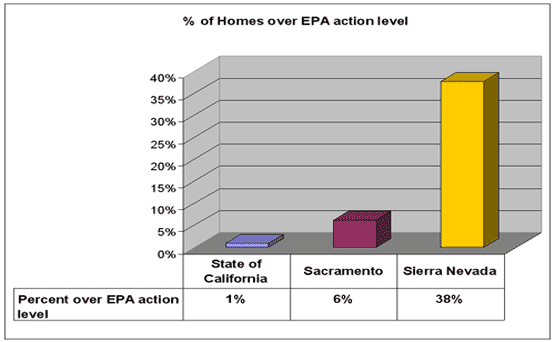
So the radon tests show that we have high radon in the Sierra Nevada . The City of South Lake Tahoe had even higher readings, 53% . So why aren't these test results causing more concern? This data is available to the public, why aren't there action plans for fixing those nearly 4 out of 10 houses, or testing more homes, or having building codes changed to reflect our knowledge of radon in this area? What is stopping our knowledge from becoming action?
Maybe a review of the facts will help us draw some conclusions:
1. The U.S. Surgeon General has identified radon as a class
I carcinogen, similar to tobacco smoke.
2. The U.S. EPA estimates that 23,000 Americans die every year
from radon induced lung cancer (that's nearly 60 people a day!).
3. The California DHS has known, at least since the 1988-89
study that up to 40% of all homes in the Sierra Nevada region
could have radon levels in excess of the EPA action level.
4. The EPA recommends that ALL homes in high radon areas be
tested for radon and fixed if found to be high, and that ALL
new homes built in these areas have radon reduction systems.
5. The State of California DHS Radon Program gives away FREE
radon test kits to all residents who request them. Radon Hot
Line 1-800-745-7236 or email request: gfaggell@dhs.ca.gov
6. The EPA has developed protocols for fixing existing houses
with high radon levels and for building out radon in new homes
(Radon Resistant New Construction - RRNC). This literature is
free.
7. The Radon Control Methods in Appendix F of the 2003 International
Residential Code are available to any building department in
high radon areas to incorporate in their local building codes.
To date, I am not aware of any building departments that have
adopted it in the Sierra Nevada region.
8. The El Dorado County Environmental Management Department
left radon out of its Community Update "purple postcard"
of public health issues in 2005, choosing instead to include
"Storm water."
9. One piece of good news is that the California DHS Radon Program has completed the Tahoe Radon Survey in the Fall of 2007. 7,700 households were asked to join the study in Placer, Nevada , and El Dorado County portions of the Tahoe Basin . 1700 responded and the results were almost exactly the same as the data showed before the study, confirming that Tahoe is a high radon area. We hope to use the results of the survey to get a radon ordinance added to our building code.
10.
But sadly, the major players like builders, architects, real
estate, environmental health agencies, building inspectors,
and even home owners and buyers have pretty much ignored radon.
If they would get informed, this group could be a positive force
in responding to radon in our community.
Conclusion: As always, it falls to individual home owners
to take responsibility for their own family's health and safety.
-
If you live in the Sierra Nevada region, test your own home.
In fact, if you are reading this, test your home. 43 houses
in the Sacramento region had high readings, even though the
area as a whole is not a high radon area. The only way
to know is to test.
- If
you are building a house, encourage your builder, architect
or building inspector to get informed on radon. You might
convince a few forward thinking individuals to take radon
seriously and to act accordingly.
Many
houses DON'T have radon
The EPA estimates that only 1 in 15 houses in the US has high
levels of radon (4 pCi/L and above). This may be comforting
to 14 of the 15 homeowners but leaves 1 homeowner shaking in
his boots. But who is the one with the problem? Without testing
EVERY home, it's like a 20 year game of Russian Roulette. How
comforting is that? And in certain high risk areas like Lake
Tahoe and the Zone 1 counties of Ventura and Santa Barbara in
California, and Douglas, in Nevada, the estimates from radon
testers is more like 1 home in 8. The study above shows
4 in 10 in the Sierra Nevada region and 1 in 2 in the City of South Lake Tahoe! Testing is the
only way to know.
Building
Codes
Local building inspectors and planners have not required compliance
with EPA radon standards. In some cases the Uniform Building
Codes need to be brought up to date so inspectors make radon
testing a part of many home improvement projects. This is done
in the medical profession, where your blood pressure is now
taken on most routine doctor visits to screen for high readings
whether you went in for high blood pressure or not. (I address
these issues in "Our Protection" section. Addressing
the special needs of new construction radon prevention requires
new training for most building inspectors. Read the International
Residential Code, Appendix F for Radon Control Methods that
could be adopted by any local building department in a high
radon area.
Real
Estate
When buying or selling a home, radon testing and mitigation
is only performed if specifically requested by one of the parties,
usually the buyer, but agreed to by both. One might think that
the time of a property sale would be a good time to test for
radon, but many factors work against this. First is the chance
that high radon levels will be found and mitigation efforts
will take more time and money than the parties want to spend.
Once high levels of radon are discovered, the seller must, by
law, disclose this fact to all prospective buyers, with the
likely consequence of reducing the demand for the house. In
a "seller's market", the seller's agent may advise
his client to deny the request for testing in the hopes of avoiding
a negative report on the record, and simply move on to other
interested buyers who may not request a radon test.
Termite
inspections have become a requirement of property sales in most
states, partly because financial institutions want to protect
their interests in the house they lend money on. The sad fact
that untested high levels of radon gas may cause lung cancer
for the inhabitants of the dwellings in 20 years, does not directly
effect the value of the property, and as such does not generate
pressure from the powerful financial, real estate, or other
interests to lobby for changes to the sales requirements. Until
the time when politics and economics team up with compassion
to make radon testing a requirement prior to a sale, home owners
are left with the responsibility to do their own testing and
mitigation efforts.
Another
problem with radon testing for real estate sales is that the
parties may wish opposite results and a true and fair test may
be corrupted by either party to promote their own interests.
Thus the inexpensive laboratory processed test kit or the moderately
priced electronic continuous radon gas detector are prone to
tampering and not suitable for real estate sales. Certified
Radon Testers with their $4000+ anti-tamper, multifunction testing
units usually charge $350 to $500, but their services can be
trusted to be fair and impartial.
 Ignorance
is bliss? Ignorance
is bliss?
If we continue to ignore the problem will it really go away?
As our knowledge of radon increases, and public pressure grows,
it will be interesting to see how our State and local real estate
associations approach radon. Will they encourage radon testing
on all houses and rentals? Will they see the testing as being
in the best interests of their clients, without being required
to by law (self-regulation, if you will)? Please see the comments
under Real Estate in the Solutions section.
Click
here to read Nevada's message to real estate professionals:
Why
Do Real Estate Professionals
Need to Know About Radon?
National Association
of Realtors
In May of 1993, the National Association of Realtors (NAR) joined
the EPA in urging all Americans to test their homes for radon.
NAR encouraged state associations to develop and support legislation
or regulation requiring mandatory
property condition disclosure, including radon, by the seller.
So far, this has not happened in Nevada or California.
In 1996 three real estate sales agents were found guilty and fined $30,000 for not disclosing radon tests in a real estate transaction in Pennsylvania. http://www.realtor.org/rmomag.nsf/pages/lawyouoct1996
NAR offers courses on radon for its members through
Realtor University
Radon, Lead, and Mold: Issues in Real Estate
http://www.realtor.org/edmatrix.nsf/0/ccaece9cc56605e786256e21006a1efb?OpenDocument
"In cooperation with the Environmental Protection Agency, the National Association of REALTORS® developed this course to educate the real estate professional on environmental hazards including what to look for and who to call for abatement.
Course topics include Health Risks of Radon, Safe Radon Levels, Testing & Mitigation Needs & Methodology, Disclosure Requirements"
(see Word document if either above web pages is out of date)
Responsible and concerned real estate agents can take courses like these to become informed, to inform their clients and to avoid liability lawsuits. Renters
This opens up a can of worms! Over one-third of all housing
units in this country are rental units. Most of these are either
single family houses or apartments located below the third floor
of a building. In most states, owners are required generally
to keep their properties "habitable" - safe and fit
for people to live in. Fixing a radon problem usually involves
repairs to the building. Therefore, it is the building owner
- and not the tenant - who is authorized to have this work done.
Property owners may simply not choose to test their buildings
since they percieve the work to be costly and since even the
awareness of a high level reading might require
them to do the repairs or at least disclose that information
to the tenant or perspective buyers. It is unclear what the
legal ramifications of testing or not testing will be. See the
Solution section for things tenants can do to deal with these
problems.
Non-resident
home owners
I have heard that nearly three quarters of the home owners at
Tahoe don't live here year-round. How concerned should they
be about testing and mitigating a house they don't live in much?
I guess they could say why bother to take out the garbage or
clean the house if they don't live in the house much? When they
are vacationing they are living in it and breathing air in it.
It's true that the EPA assesses risks of exposure to high levels
of radon over long periods of time, so short stays may not cause
much of a risk. But who want's to breath dirty indoor air, even
for a little while? No amount of radiation is without risks,
even significant risks. Non-resident homeowners should at least
take the test and then decide if the
levels are high enough to warrant the mitigation costs. Currently California offers test kits for $5.
"But
it's not URGENT!"
Possibly the biggest problem in getting many homeowners to test
for, let alone correct, high radon readings, is that it's not
a high priority. Radon does not pose an immediate danger. Some
homeowners may think "Sure radon is bad, but what's the
chance I even have it, or if I do, it may not be high, and then
what's the chance I will really get cancer from it? And the
whole process is complicated, confusing and expensive. And frankly
I am not that comfortable thinking about cancer and death and
spending money on repairs I don't know anything about. I would
rather be doing something else, anything." Let's face it,
if the risk seems small and the hassle is huge, people have
other pressing, urgent (and more pleasant) things on their plate,
and radon testing often gets put off to the indefinite future.
Action
without panic
Our goal, at Radon at Tahoe, is
to get everyone at Tahoe to test their house for radon
and then fix it if it's high. The question is: How do we move
the bar of awareness to get people to act without causing undue
worry or panic? Luckily, most of us will find no problem. So
why get everyone upset? Well, it takes getting everyone concerned
enough to test to ferret out the few with the problem. Who of
us would deny those folks a solution that only testing will
find? And what's the cost? The test is FREE! Of course,
if you want the benefit of a continuous monitor to test your
house over time and then help your friends and neighbors test
theirs, you can buy a continuous radon monitor. Either way don't
panic, take action. Take the Test.
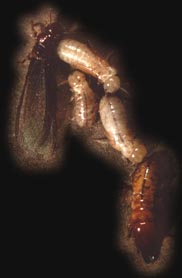 Termites and Radon: Is there a connection? Termites and Radon: Is there a connection?
Will treating a house for radon increase the chance of termites? Will laying down a radon barrier cloth over the previously dry, aired-out soil under a house, change the soil's moisture content to make it a breeding ground for termites? Will effective radon treatment make effective termite treatment difficult or impossible?
These questions were brought up by my friend Ole Olson of Mountain Termite of South Lake Tahoe. I did some research and found surprisingly nothing written on the topic so I addressed my concerns to a termite researcher, Dr. Vernard Lewis, of the University of California, Berkeley, a radon scientist at the EPA, and the members of the professional radon group, AARST. Read my letter while we await their response.
Responses:
James Long, EPA:
I have forwarded your comments to a radon mitigation person here. I did a quick look around our site and did not find any discussion of pests or termites or infestation related to radon mitigation systems. I did a google search and noted that a number of home inspectors in more than a couple of states offer multi-tiered inspection services for radon and termites. Have you spoken to any of the local home inspectors to see what they recommend and how they deal with the issue? Just a suggestion...
(Note: In California, radon testing and mitigation require certifications that no home inspectors in the Tahoe Area currently possess, according to the California Department of Public Health Radon web page (as of 2-1-08).. Also, termite inspection requires a sepatate license in California and is performed by termite inspection companies. I have found no one locally knowledgeable on the topic of termites and radon.) Mitigation person, EPA:
...A submembrane depressurization technique in theory could weaken ( dilute ) a already existing pesticide application in a exposed earth crawlspace because of the increased ventilation taking place under the membrane. I have no working experience with this theory. The amount of ventilaion that takes place under the membrane would depend on a number of things like : Is the membrane tightly sealed to the foundation walls and to other structural components and how much replacement air is coming from outside the foundation walls. Not knowing the life cycle of termites, I don't think the membrane would stop the termites from returning to the soil because they could go outside the foundation walls. If I'm not mistaken the pesticide application can take place inside and outside the crawlspace foundation wall. So if a radon system is in place the application can take place on the outside. My only recall on a potential problem with pesticide application and radon systems is when a subslab pressurizaion system technique is employed and the pesticide vapors can be forced into tje living space.
Posted by Gary Hodgden from AARST on Wednesday, January 30, 2008 - 02:20 pm: With plastic sheeting, it would not seem realistic that moisture content of soil beneath would alter the habits of termites.  They travel regardless of moisture wherever they can find food (cellulose). A cloth soil barrier is a problem for life span of the membrane as well as anything that might be composed of cellulose (termite bait). G Hodgden They travel regardless of moisture wherever they can find food (cellulose). A cloth soil barrier is a problem for life span of the membrane as well as anything that might be composed of cellulose (termite bait). G Hodgden
Posted by Dave Hill from AARST on Wednesday, January 30, 2008 - 03:54 pm: I agree with Gary. I would also like to add that your depressurization system should be preventing the build-up of moisture under the barrier. In fact, the system should substantially reduce the moisture entry into the crawlspace itself. Which is good for reducing insect activity in general. Dave Hill
Conclusions
The consensuses is that radon abatement should not create a termite problem because the system actually dries out the soil in the process of eliminating radon from under the radon barrier. However, what was not mentioned is that a correct radon installation should not have the radon barrier or plastic sheeting attached to wood, either on the support posts or on the sill plate above the foundation wall. Doing so would allow termites to migrate up into the wood, under cover of the radon barrier and be out of view unless the barrier cloth was removed for inspection, a tiresome job! It's important to use a good polyurethane adhesive, such as S-M SM7108 (see Supply Page) that adheres the radon barrier and plastic to concrete block. This will keep all wood exposed to air and allow for visual termite inspection without removing the radon barrier.
Risk Assessment
No level of radon exposure is safe A 1996 study by the National Institute of Health found that even at the 4 pCi/L "action level" of the EPA, a person's risk of developing lung cancer increased 14% over 30 years of exposure.
Excerpt: Based on the eight studies combined, Lubin and Boice estimated that the risk of developing lung cancer increased 14 percent for a person living 30 years in a house with a radon level of 150 Becquerels per cubic meter (Bq/m 3 ). This is approximately equal to 4 picocuries per liter, the level at which the U.S. Environmental Protection Agency recommends taking action to reduce radon in a house. About 6 percent of U.S. houses have radon levels at or above 150Bq/m 3 . The meta-analysis findings are subject to uncertainty because they are based on combined data from studies done in different ways with inconsistent results. But the risk estimate derived from the meta-analysis is very close to the 13 percent increased risk that is estimated by extrapolating results from an analysis of pooled data from 11 underground miner studies to the lower levels of radon exposure in the household setting.
"Our results suggest that the current method of extrapolation from miner studies provides a reasonable estimate of the lung cancer risk for people exposed to elevated radon levels in their homes," Lubin said. "The fact that our risk calculations are consistent with the risk figures based on miner studies offers some assurance that estimates of household radon risk are not far off the mark."
Read NIH press release.
A Review of Residential Radon Case-Control Epidemiologic
Studies Performed in the United States |